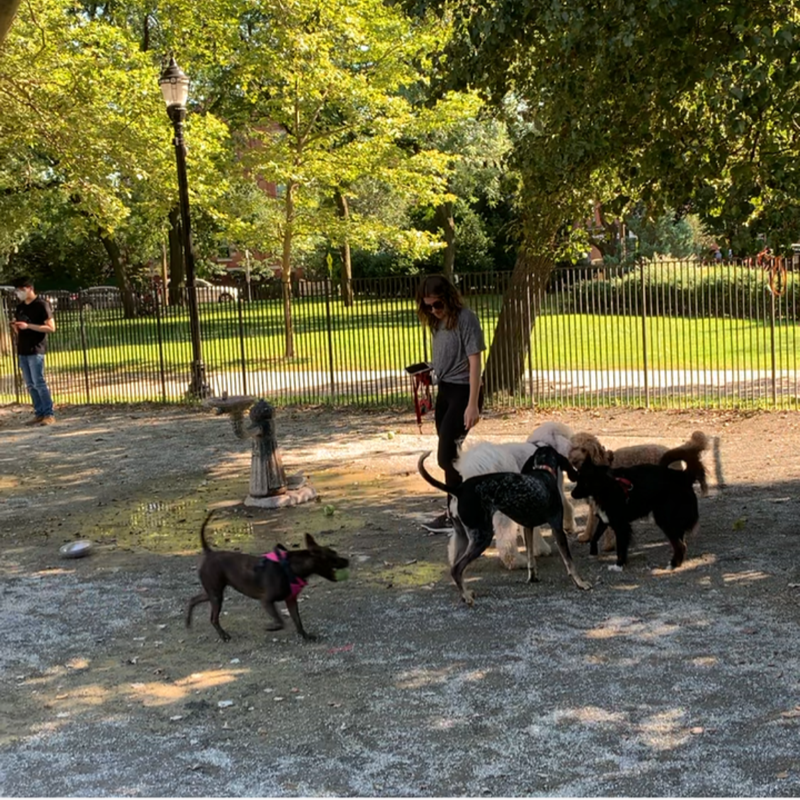Key Takeaways
Urban dogs require specific exercise routines tailored to the limitations of city living.
Choosing the right dog park involves considering safety, space, and the temperament of your dog.
Leash walking in the city demands a balance of obedience and awareness for both pet and owner.
Indoor activities and agility training can supplement outdoor exercise for dogs in urban areas.
Mental stimulation is as crucial as physical exercise to ensure a well-rounded urban dog lifestyle.
“Two Pitties in the City: City Dog: On …” from pittiesincity.blogspot.com and used with no modifications.
Why Urban Dogs Need Tailored Exercise Plans
Dogs living in cities face a very different set of circumstances compared to their suburban or rural counterparts. The bustling streets, compact living spaces, and the sheer number of people and dogs around can make a standard ‘walk in the park’ a bit more complicated. That’s why it’s so important to create a tailored exercise plan that keeps your furry friend healthy, happy, and out of trouble.
Dog Exercise Needs in the Concrete Jungle
Just like us, dogs need regular exercise to stay fit and burn off extra energy. In the city, though, you can’t just open the back door and let them run. We need to be more inventive. Exercise for urban dogs isn’t just about physical activity; it’s about mental stimulation too. They need to navigate through crowds, respond to a variety of sounds, and still find ways to be a dog amidst the concrete.
Most importantly, your dog’s exercise should be consistent and varied. Consistency helps establish a routine, while variety keeps things exciting. Think beyond the walk—incorporate activities like fetch in a fenced-in tennis court or hide-and-seek in your living room.
Challenges of Urban Spaces for Dog Workouts
One of the biggest challenges in urban areas is limited space. Dog parks can be crowded, and sidewalks can be narrow. Besides that, there’s the issue of safety—both in terms of traffic and the potential for encounters with aggressive dogs. Therefore, it’s essential to know your environment and plan your dog’s exercise accordingly.
“Dog parks in Jersey City | Summer with …” from jcfamilies.com and used with no modifications.
Finding the Right Dog Park: A Guide for City Dwellers
When it comes to dog parks, not all are created equal—especially in the city. Here’s what to look for:
Qualities of a Safe and Stimulating Dog Park
Size: Look for parks that offer enough space for dogs to run freely without overcrowding.
Fencing: Ensure the park is fully enclosed with secure gates to prevent escape artists from getting out.
Separation: Ideally, there should be separate areas for large and small dogs to keep playtime safe.
Cleanliness: A well-maintained park is a healthy park. Check if there are stations for waste disposal and fresh water available.
Remember, your dog’s temperament is a key factor in whether a dog park is a good fit. If they’re not comfortable with other dogs or get overwhelmed easily, it might be best to find alternative forms of exercise.
Canine Etiquette: Maximizing Your Visit Without the Mishaps
Good manners go a long way at the dog park. Here’s how to ensure a positive experience:
Watch your dog at all times and be ready to intervene if play gets too rough.
Keep your dog’s vaccinations up to date for the safety of all park-goers.
Never bring food into the park to avoid unnecessary tension among the dogs.
And don’t forget to practice entering and exiting the park calmly. This sets the tone for your dog’s behavior and can prevent a chaotic rush at the gates.
Navigating Busy Streets with Your Four-Legged Companion
City streets are a symphony of sounds and a mosaic of movements that can be overwhelming for your dog. It’s crucial to keep them close and under control. Use a sturdy, non-retractable leash to maintain a secure grip, and always be on the lookout for potential hazards like broken glass or unexpected encounters with other dogs. The goal is to create a safe and enjoyable walk where your dog feels secure and is able to focus on your guidance.
Keeping Up the Pace: Combining Exercise and Obedience
Leash walks are more than just physical exercise; they’re an opportunity for obedience training. As you walk, practice commands like ‘sit’, ‘stay’, and ‘heel’. This not only reinforces good behavior but also keeps your dog mentally engaged. Use positive reinforcement like treats or praise to reward your dog for following commands amidst distractions. The result? A dog that’s not only physically fit but also well-behaved.
Creative Exercise Solutions Beyond Dog Parks and Sidewalks
When the usual dog park or sidewalk route grows stale, it’s time to get creative. Look for staircases where your dog can climb for an extra challenge, or find a safe rooftop area where they can run freely. You can also consider activities like tug-of-war or fetch in your living room to keep them moving on rainy days.
Here’s a quick list of creative urban exercise ideas:
Stair climbing in public spaces or your apartment building
Indoor fetch using a long hallway or open space
Tug-of-war with their favorite rope toy
These activities not only add variety to your dog’s exercise regimen but also strengthen the bond between you as you both engage in playful interaction.
Indoor Activities to Keep Urban Dogs Active and Engaged
Indoor activities are a lifesaver for urban dog owners, especially during inclement weather. Create an obstacle course with cushions or boxes, encourage your dog to play hide-and-seek, or invest in interactive toys that challenge them to solve puzzles for treats. These games keep your dog’s body and mind active, which is vital for their overall well-being.
Urban Agility and Training Clubs: Turning Energy into Talent
Urban agility clubs offer a structured way for your dog to burn energy and learn new skills. These clubs often have equipment like tunnels, jumps, and weave poles that can turn a simple exercise routine into an exciting sport. It’s not only a great workout but also a fantastic way to meet other dog owners who share your commitment to responsible pet ownership.
For example, an urban agility club might host weekly training sessions where dogs can learn to navigate an obstacle course. This provides both physical exercise and mental stimulation, and it’s a lot of fun for everyone involved.
Agility training is also a great way to build confidence in shy dogs and provide an outlet for high-energy breeds that thrive on challenges.
Responsible Dog Ownership: Beyond Basic Walks and Runs
Being a responsible dog owner means recognizing that your dog’s needs go beyond the basic walks and runs. It’s about ensuring they get the right amount of exercise, social interaction, and mental stimulation to live a happy, healthy life. This might mean adjusting your schedule to fit in an extra walk or spending time on the weekend exploring new parks.
It’s also about being considerate of others. Always pick up after your dog, keep them leashed where required, and respect the space of other dogs and their owners. By setting a good example, you help create a community that’s friendly and safe for all dogs and people.
And remember, exercise is a daily requirement, not a once-in-a-while treat. Your dog depends on you to help them get the activity they need, so make it a priority in your life. When in doubt, a little extra playtime is always a good idea.
Here are a few more tips to ensure you’re a responsible dog owner:
Understand your dog’s breed-specific exercise needs
Keep up with regular vet check-ups to monitor your dog’s health
Invest in proper training so your dog can navigate urban environments safely
Always be aware of your dog’s behavior and energy levels. If they seem more sluggish or hyperactive than usual, it might be a sign that their exercise routine needs adjustment.
The Importance of Mental Stimulation Alongside Physical Exercise
Mental stimulation is just as important as physical exercise. Dogs that are mentally engaged are less likely to develop destructive behaviors borne out of boredom or excess energy. Incorporate training sessions into your daily walks, use puzzle feeders at meal times, and rotate their toys to keep things interesting.
Community and Environmental Considerations for Dog Owners in Urban Areas
Living in an urban area means sharing space with a lot of people and their pets. It’s important to be mindful of how your dog’s behavior affects the community. Train your dog to respond to commands even in distracting environments, and always be considerate of your neighbors—human and canine alike. Additionally, be environmentally conscious by using biodegradable waste bags and supporting local parks and pet-friendly spaces.
By taking these steps, you’ll not only provide a great life for your dog but also contribute positively to the urban community you’re both a part of.
FAQ
How can I exercise my dog if I live in a high-rise building or small apartment?
Exercising your dog in a high-rise building or small apartment requires creativity. Use hallways for games of fetch or hide-and-seek. Invest in interactive toys that challenge your dog mentally and physically. Consider short, frequent walks outside and look for dog-friendly spaces nearby where your dog can run freely. You can also join a local dog walking group to combine socialization with exercise.
What are the signs that my dog isn’t getting enough exercise?
If your dog isn’t getting enough exercise, they might exhibit signs such as excessive barking, restlessness at night, destructive behavior, and weight gain. You might also notice a decrease in muscle tone and a reluctance to engage in activities they once enjoyed. It’s important to recognize these signs early and adjust their exercise routine accordingly.
How long should leash walks last for city dogs?
The duration of leash walks for city dogs can vary depending on the breed, age, and health of your dog. A good rule of thumb is at least 30 minutes to an hour of walking per day, which can be split into shorter walks if necessary. However, some active breeds may require more exercise to stay happy and healthy.
What should I do if my dog shows aggressive behavior at dog parks or on walks?
If your dog shows aggressive behavior, it’s essential to address it immediately. Consult with a professional dog trainer or behaviorist to determine the cause and work on a training plan. Always keep your dog on a leash and under control, and avoid situations that trigger their aggression until they are properly trained.
Are there any alternatives to dog parks for socializing my pup?
Absolutely, there are several alternatives to dog parks for socializing your pup. Arrange playdates with dogs they are familiar with in a controlled environment. Enroll your dog in obedience classes where they can interact with others under supervision. Explore new neighborhoods on walks, or visit pet-friendly establishments to help them become accustomed to different people and environments.
As a dog owner, it’s important to understand the responsibilities that come with taking your furry friend to public spaces like dog parks and adhering to leash laws during walks. Ensuring your dog is well-behaved and considerate of others contributes to a positive environment for everyone.







